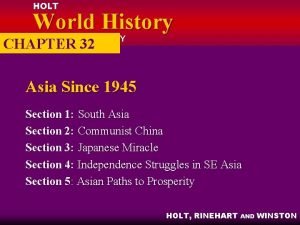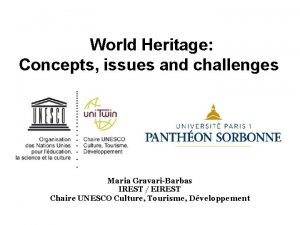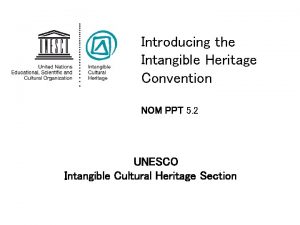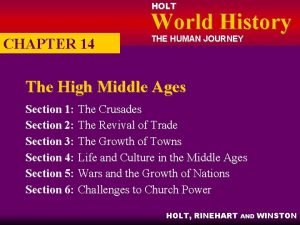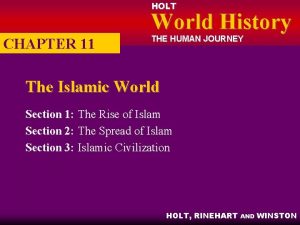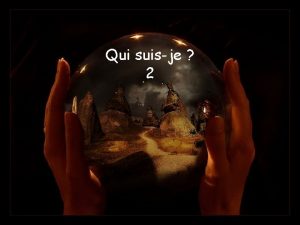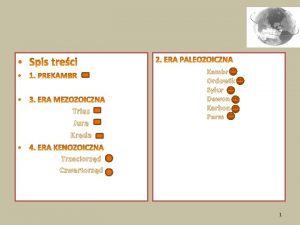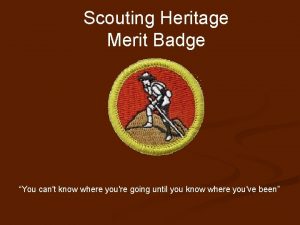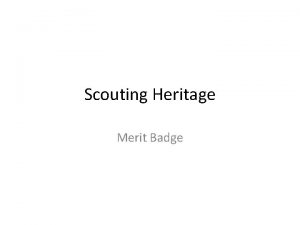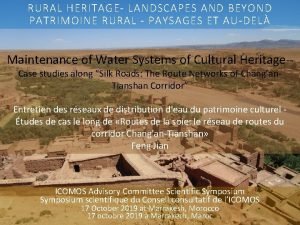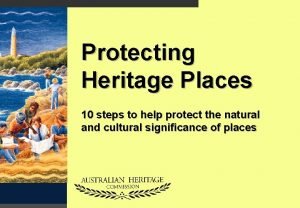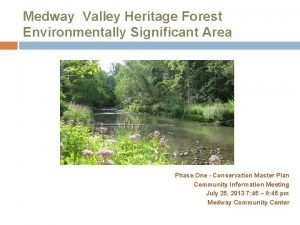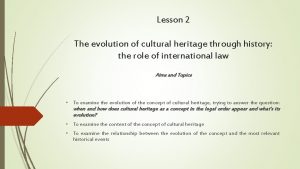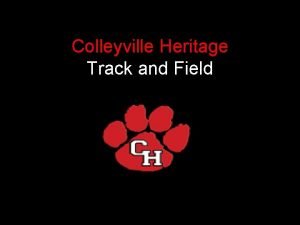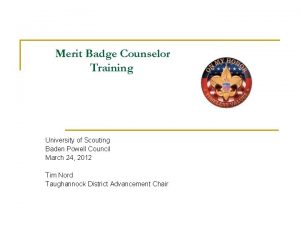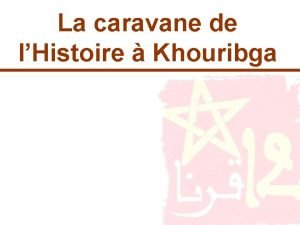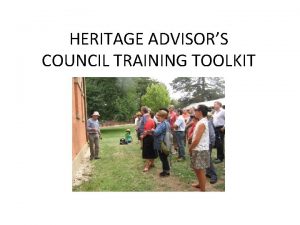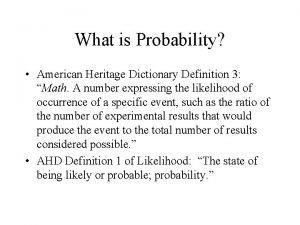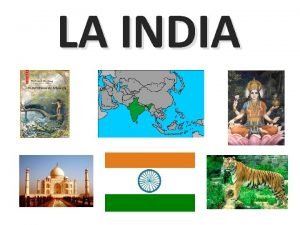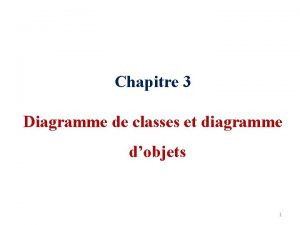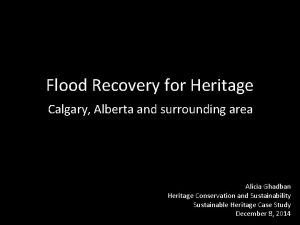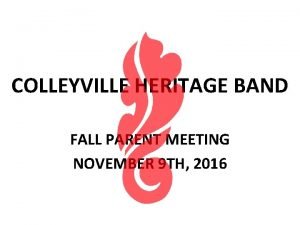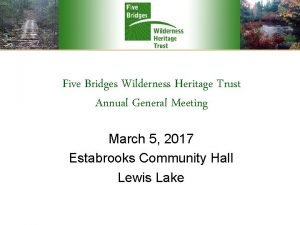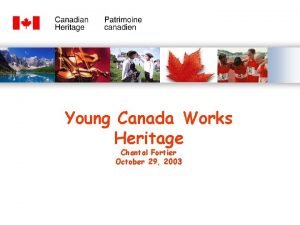Presentation Plus Human Heritage A World History Copyright






















































































- Slides: 86

Presentation Plus! Human Heritage: A World History Copyright © by The Mc. Graw-Hill Companies, Inc. Developed by FSCreations, Inc. , Cincinnati, Ohio 45202 Send all inquiries to: GLENCOE DIVISION Glencoe/Mc. Graw-Hill 8787 Orion Place Columbus, Ohio 43240


CHAPTER FOCUS SECTION 1 The Paleolithic Age SECTION 2 The Neolithic Age CHAPTER SUMMARY & STUDY GUIDE CHAPTER ASSESSMENT 3 Click a hyperlink to go to the corresponding section. Press the ESC key at any time to exit the presentation.

Overview • Chapter 2 deals with the Paleolithic and Neolithic ages. – Section 1 focuses on the lifestyle of the earliest humans–the food gatherers of the Paleolithic, or Old Stone, Age. – Section 2 describes the developments of the Neolithic, or New Stone, Age–the beginning of farming, the domestication of animals, and the formation of villages. 4 Click the mouse button or press the Space Bar to display the information.

Objectives After studying this chapter, you will be able to: • explain how tools, language, clothing, and the discovery of fire helped early people advance. • summarize what Neanderthals and Cro. Magnons were like. • describe how people changed from food gatherers to food producers. • discuss why specialization, government, and religion were important in Neolithic societies. 5 Click the mouse button or press the Space Bar to display the information.

Read to Discover • How tools, language, clothing, and the discovery of fire helped early people advance • What Neanderthals and Cro-Magnons were like • How people changed from food gatherers to food producers • Why specialization, government, and religion were important in Neolithic societies 6 Click the mouse button or press the Space Bar to display the information. The Chapter Focus is on page 33 of your textbook.

Terms to Learn • prehistory • Lucy • civilization • Neanderthals • migrate • Cro-Magnons • specialization Places to Locate • Olduvai Gorge People to Know • Jericho • Catal Hüyük 7 Click the mouse button or press the Space Bar to display the information. Click the Speaker On button to listen to the words.

Why It’s Important Most archaeologists believe people have lived on the earth for millions of years. The period of time before the invention of writing is called prehistory. It lasted until about five thousand years ago, when people learned how to write. Through the use of artifacts, archaeologists have traced the milestones that paved the way from prehistory to the rise of civilization–a time when people progressed culturally and began to live in cities. Click the Speaker On button to replay the audio. 8


10

11

12

13

14

The Paleolithic Age • Although there were no written records during prehistory, scientists have learned a great deal about prehistoric people. • Many scientists believe that until about 900, 000 years ago people lived only on the grasslands of eastern and southern Africa. • Due to climatic changes, people were able to migrate, or make their way, around the desert of northern Africa and across land bridges. 15 Click the mouse button or press the Space Bar to display the information. Section 1 begins on page 33 of your textbook.

The Paleolithic Age (cont. ) • Scientist call the first age in which people lived the Paleolithic Age, or Old Stone Age. • It lasted from about 2. 3 million years, until 10, 000 years ago. • During this period, people obtained their food by hunting and gathering. 16 Click the mouse button or press the Space Bar to display the information.

Obtaining Food • Paleolithic people lived in small bands, or groups, of about 30 members. • The people within a group lived and worked together and shared their food. • Each band searched for food within an area known as its home territory. • Women and children gathered berries, nuts, fruit, and eggs out of bird and turtle nests. • Men of the group obtained meat. 17 Click the mouse button or press the Space Bar to display the information.

Making Tools • Life for hunters and gatherers became easier when they learned to make tools. • The earliest shaped stones are known as Olduvan pebble tools, named after the Olduvai Gorge in eastern Africa where they were first discovered. • Later, people learned to knock long, sharp -edged chips called flakes from stones and use them as tools. 18 Click the mouse button or press the Space Bar to display the information.

Making Fire • People also learned to make fire during the Paleolithic Age. • People used fire … – to keep themselves warm and dry. – as a weapon, throwing burning sticks of wood at animals to drive them away. – to clear out brush and undergrowth. – to cook food. 19 Click the mouse button or press the Space Bar to display the information.

Seeking Shelter • Early people usually camped out in the open. • At first, early people used caves only for such emergencies as escaping from a sudden storm or large animal. • By about 100, 000 years ago, however, people in China, western Europe, and southwestern Asia were living in caves most of the time. 20 Click the mouse button or press the Space Bar to display the information.

Making Clothing • After hunters began killing large animals, they found that the animal skins could be used for protection and warmth. • At first, people wrapped the skins around themselves. • Later, they learned how to fasten the skins together. • Once they had clothing to protect them from the weather, they were able to move into areas that were cooler and wetter. 21 Click the mouse button or press the Space Bar to display the information.

Developing Language • In addition to learning to make tools, fire, and clothing, early people developed language. • Before they learned to talk, early people simply made sounds, or pointed to objects, to express meaning. • The development of language was a great human achievement. • It made it possible for people to work together, share ideas, and pass on their beliefs and stories. 22 Click the mouse button or press the Space Bar to display the information.

The Neanderthals • The first people on Earth are known as Homo habilis, or “skillful man. ” • Next came Homo erectus, or “man who walks upright. ” • Then, between about 300, 000 and 200, 000 years ago, came Homo sapiens, or “man who thinks. ” • There are two kinds of Homo sapiens. • The first is the Neanderthal, named after the Neander River in Germany where their remains were first discovered in 1856. 23 Click the mouse button or press the Space Bar to display the information.

The Neanderthals (cont. ) • Neanderthal people were good hunters, using pitfalls to catch large animals like the rhinoceros and the elephant. • In northern areas, they made houses by covering a framework of mammoth bones with animal skins. • According to experts, Neanderthals were also the first people to bury their dead. 24 Click the mouse button or press the Space Bar to display the information.

The Cro-Magnons • The second kind of Homo sapiens are the Cro-Magnons, named after a rock shelter in France where their remains were first discovered in 1868. • Archaeologists consider them the first modern human beings. • Cro-Magnons were very skilled toolmakers and they invented the burin, which resembles a chisel. • Using new tools made Cro-Magnons better hunters, thus increasing their food supply. 25 Click the mouse button or press the Space Bar to display the information.

The Cro-Magnons (cont. ) • Another important tool that Cro-Magnons invented was the axe, which they used to cut down trees and hollow out logs to make canoes. • Cro-Magnons also fashioned bone, ivory, and shell into body ornaments, such as necklaces and rings. • They covered the walls of some caves in western Europe, Africa, and South America with pictures painted brightly with paints made from minerals. 26 Click the mouse button or press the Space Bar to display the information.

The Cro-Magnons (cont. ) • Many anthropologists think cave paintings may have had religious significance. • Cro-Magnon bands cooperated, often hunting large animals together. • This required them to jointly agree on rules and the first true leaders. 27 Click the mouse button or press the Space Bar to display the information.

Section Assessment Why did people begin to move out of Africa and into other parts of the world about 900, 000 years ago? The climate became colder, ice sheets grew, and land bridges were created. Rain increased, changing desert to grasslands. 28 Click the mouse button or press the Space Bar to display the answer.

Section Assessment (cont. ) How did tools change in the Paleolithic Age? They changed from sticks and stones to shaped tools. 29 Click the mouse button or press the Space Bar to display the answer.

Section Assessment (cont. ) Analyzing Information What do you think was the most important advancement made by early people? Explain. Answers will vary. 30 Click the mouse button or press the Space Bar to display the answer.

Section Assessment (cont. ) Draw a diagram like the one found on page 40 of your textbook. Use it to compare ways of life followed by the Neanderthals and Cro-Magnons. Be sure to include the accomplishments of each. 31


The Neolithic Age • In the Neolithic, or New Stone, Age about 8000 B. C. , people changed from food gatherers to food producers. • Over several thousand years they began to obtain most of their food from farming. • This brought about such great changes in the way they lived that experts call the beginning of farming the Neolithic Revolution. 33 Click the mouse button or press the Space Bar to display the information. Section 2 begins on page 41 of your textbook.

Farmers and Herders • Two important discoveries brought on the Neolithic Revolution. – One was learning to grow food. – The other was learning to herd animals. • Scientists believe agriculture developed independently in different parts of the world. • People probably learned they could herd animals when a hunting band built fences to enclose a herd of wild animals they had chased into a ravine. 34 Click the mouse button or press the Space Bar to display the information.

Farmers and Herders (cont. ) • Soon captured animals began to lose their fear of people and became domesticated, or tamed, and the hunters became herders. • The Neolithic Revolution greatly increased people's food supply. • With more food available, the population, or number of people, began to grow. 35 Click the mouse button or press the Space Bar to display the information.

Early Villages • Once people began to produce food, they were able to settle in one place. • The earliest known villages in the world have been found in southwestern Asia. • Two of the oldest are Jericho in presentday Israel, which dates back to about 8000 B. C. and Abu Hureyra in present-day Syria, which was established about 500 years later. • Another early village is Catal Hüyük located in present-day Turkey. 36 Click the mouse button or press the Space Bar to display the information.

Early Villages (cont. ) • Archaeologists know a great deal about Catal Hüyük because it was struck by a fire that blackened rather than destroyed wooden and cloth objects. • Evidence shows the houses in Catal Hüyük were made of sun-dried mud brick. • As protection against attack, the houses in this village had two or three rooms and no doors. • Among the houses stood courtyards with large ovens for baking bread. 37 Click the mouse button or press the Space Bar to display the information.

Specialization • A result of increased food supplies was specialization, or the development of occupations. • As fewer people were needed to produce food they became potters, weavers, and metal workers. • Specialization was aided by a number of developments. – People learned to make pottery by baking clay. – People learned to weave cloth. – People also learned to work metals. 38 Click the mouse button or press the Space Bar to display the information.

Government • Another development of Neolithic times was village government. • It was more complex than government in earlier times due to land ownership and the disputes that arose. • To keep order in Neolithic villages, a single chief was chosen. 39 Click the mouse button or press the Space Bar to display the information.

Religion • Experts believe that the chiefs of most Neolithic villages were also priests. • At first, Neolithic people prayed to the forces of nature that they saw around them. • After a time, they created gods and goddesses to represent these forces. • Archaeologists believe that more elaborate religious customs and ceremonies appeared at this time. 40 Click the mouse button or press the Space Bar to display the information.

Section Assessment What two important discoveries changed people from food gatherers to food producers? Farming and herding changed people from food gatherers to food producers. 41 Click the mouse button or press the Space Bar to display the answer.

Section Assessment (cont. ) What were two results of the increased food supply during the Neolithic Age? The population increased and specialization occurred. 42 Click the mouse button or press the Space Bar to display the answer.

Section Assessment (cont. ) What roles did the village chiefs play? They were rulers and priests. 43 Click the mouse button or press the Space Bar to display the answer.

Section Assessment (cont. ) Understanding Cause and Effect How did learning to produce food lead early civilizations to develop villages? People had to learn to produce food before they could settle in villages because farming provided a steady food supply and people no longer needed to hunt and gather food in nomadic bands. 44 Click the mouse button or press the Space Bar to display the answer.

Section Assessment (cont. ) Draw a diagram like the one found on page 46 of your textbook. Use it to show the cause and effects of the development of farming. Cause: discovered that seed from wild grains could be planted and harvested Effects: increased food supply, growth of the world’s population, rise of early villages, specialization, development of government (to settle land disputes), and so on 45 Click the mouse button or press the Space Bar to display the answer.


Chapter Summary & Study Guide • Prehistoric time can be divided into the Paleolithic and Neolithic Ages. • During the Paleolithic Age, people lived in small hunting-and-food-gathering bands. • Over time, Paleolithic people learned to make tools and clothes, developed language, and discovered how to make fire. • Early Homo sapiens included the Neanderthal and the Cro-Magnon. 47 Click the mouse button or press the Space Bar to display the information.

Chapter Summary & Study Guide (cont. ) • The shift from food gathering to food producing brought so many changes that it has been called the Neolithic Revolution. • Food production made it possible for people to settle in one place and develop villages. • Increased food supplies in the Neolithic Age resulted in increased population and specialization. • Neolithic villagers learned to make pottery, invented the loom, and began to work metals. 48 Click the mouse button or press the Space Bar to display the information.

Chapter Summary & Study Guide (cont. ) • Neolithic village government was led by a chief who settled disputes and directed village activities. 49


Understanding the Main Idea What is the main difference between the Paleolithic and Neolithic ages? The main difference is the way people got food. 51 Click the mouse button or press the Space Bar to display the answer.

Understanding the Main Idea Why did Paleolithic people move from place to place? They moved to search for food. 52 Click the mouse button or press the Space Bar to display the answer.

Understanding the Main Idea How did early men and women share the work of getting food? Women gathered berries, nuts, eggs, roots; men hunted. 53 Click the mouse button or press the Space Bar to display the answer.

Understanding the Main Idea How did the discovery of fire affect people’s lives? It enabled early people to cook food, keep warm, frighten animals, and refine weapons. 54 Click the mouse button or press the Space Bar to display the answer.

Understanding the Main Idea What difference did clothing make in the way people lived? It protected early people from the weather, enabling them to move to cooler and wetter regions. 55 Click the mouse button or press the Space Bar to display the answer.

Understanding the Main Idea Why did the Cro-Magnons produce cave paintings? They thought that creating an animal in paint gave them a kind of magic power over its spirit. 56 Click the mouse button or press the Space Bar to display the answer.

Understanding the Main Idea How did increased food supplies cause increased population? More food was available to support larger numbers of people, and people lived longer. 57 Click the mouse button or press the Space Bar to display the answer.

Understanding the Main Idea Why did people in the Neolithic Age begin to take up different occupations? When fewer people were needed to produce food they began to take up jobs that had nothing to do with food production. 58 Click the mouse button or press the Space Bar to display the answer.

Understanding the Main Idea How did people in the Neolithic Age change their form of government? They chose a chief to settle disputes and direct village activities. 59 Click the mouse button or press the Space Bar to display the answer.

Critical Thinking Do you think the development of farming should be called a revolution? Explain Answers will vary but should indicate that farming was a momentous development. 60 Click the mouse button or press the Space Bar to display the answer.

Critical Thinking What would you have liked about living in Catal Hüyük? What would you have disliked? Answers will vary. 61 Click the mouse button or press the Space Bar to display the answer.

Critical Thinking How would you have organized work activities if you had been a village chief? Answers will vary. 62 Click the mouse button or press the Space Bar to display the answer.

Geography in History Place When early people began to build shelters, they used some geographic features to decide where they would build their homes. What features affected their choice of building sites? How might geography affect their choice of building materials? Answers may vary but should include consideration of mountains, rivers and streams, valleys, and swamps. 63 Click the mouse button or press the Space Bar to display the answer.

Imagine you are a Neolithic person who has just survived an avalanche. How might this natural disaster make life harder? How might it make life easier? 64


Explore online information about the topics introduced in this chapter. Click on the Connect button to launch your browser and go to the Human Heritage: A World History Web site. At this site, you will find interactive activities, current events information, and Web sites correlated with the chapters and units in the textbook. When you finish exploring, exit the browser program to return to this presentation. If you experience difficulty connecting to the Web site, manually launch your Web browser and go to http: //www. humanheritage. glencoe. com 66

4000 B. C. 8000 B. C. New Stone Age begins World population reaches about 90 million 6500 B. C. Catal Hüyük established 67 Click the mouse button or press the Space Bar to display the information. 3000 B. C. Writing is invented

Lucy c. 3, 200, 000 B. C. Hominid Skeleton Lucy made headlines in 1974 when two scientists–Donald C. Johanson and Tom Gray–discovered her skeleton in the deserts of Ethiopia. They named her after a popular Beatles song, “Lucy in the Sky with Diamonds. ” Although Lucy walked the earth 3. 2 million years ago, her skeleton was nearly complete. She gave the world its first look at an early prehuman. 68

First Razors The Flute 69 Click a hyperlink to go to the corresponding section. Press the ESC key at any time to exit the presentation.

First Razors Cro-Magnons may have invented the first razors. Some Cro-Magnon cave paintings portray beardless men, and Cro-Magnon graves contain sharpened shells–the first razors. Later peoples hammered razors out of bronze or iron. 70

The Flute The first musical instrument invented by early humans was the flute. Carved bone flutes date back more than 30, 000 years. 71

First Farmers Many archaeologists believe that women invented the practice of agriculture. In societies of huntergatherers, women collected fruits, nuts, and seeds. As they did so, they probably noticed that plants sprouted where seeds fell. Only with the invention of the plow did men take over the job of farming. 72

Oldest Tools Languages Early Art 73 Click a hyperlink to go to the corresponding section. Press the ESC key at any time to exit the presentation.

Oldest Tools In 1995, archaeologists working in Ethiopia found stone spear points more than 2. 6 million years old, making them the earliest tools found on earth. 74

Languages There may be 2, 000 to 10, 000 languages in the world today. Dialects or variations within a language, range from about 20, 000 to more than 50, 000. The largest native language in the world is Chinese, but among the many dialects are Mandarin, Cantonese, Wu, Min, Xiang, Kan, and Hakka. 75

Early Art Paleolithic artists used three basic colors: black, red, and yellow. The pigments came from natural sources such as charcoal, clay, and minerals such as iron. They used these materials so skillfully that when Pablo Picasso, one of the masters of modern art, saw cave paintings in France, he reportedly exclaimed: “We have invented nothing!” 76

Religion Four out of five people in the world say they practice some form of religion. The five largest world religions are Christianity, Islam, Hinduism, Buddhism, and Judaism. 77

Determining Relative Location • Most maps show direction, or the line of course along which something is pointing or facing. • Understanding direction makes locating places, whether on a map or in a town, much easier. • All directions heading toward the North Pole are north (abbreviated N), and all directions heading toward the South Pole are south (S). Continued on next slide. 78 Click the mouse button or press the Space Bar to display the information.

Determining Relative Location • When facing the North Pole, the direction to the right is east (E) and to the left is west (W). • These four main directions are called cardinal directions. • There also four other directions, which are known as intermediate directions. Continued on next slide. 79 Click the mouse button or press the Space Bar to display the information.

Determining Relative Location • This is because they are located between the cardinal directions. • The direction between north and east is northeast (NE) and between north and west is northwest (NW). • The direction between south and east is southeast (SE) and between south and west is southwest (SW). Continued on next slide. 80 Click the mouse button or press the Space Bar to display the information.

Determining Relative Location Study the map on page 44 of your textbook showing sites of early people. Then answer the questions that follow. Continued on next slide. 81

Determining Relative Location What sites are located southwest of Neanderthal? Cro-Magnon and Le Moustier Continued on next slide. 82 Click the mouse button or press the Space Bar to display the answer.

Determining Relative Location Which site is south of Broken Hill? Boskop Continued on next slide. 83 Click the mouse button or press the Space Bar to display the answer.

Determining Relative Location In which direction is Ngandong from Teshik-Tash? southeast 84 Click the mouse button or press the Space Bar to display the answer.

End of Custom Shows WARNING! Do Not Remove This slide is intentionally blank and is set to auto-advance to end custom shows and return to the main presentation.

 World heritage is our heritage slogan
World heritage is our heritage slogan Human heritage a world history
Human heritage a world history Coparcenary property and separate property
Coparcenary property and separate property Sapratibandha daya and apratibandha daya
Sapratibandha daya and apratibandha daya Human heritage chapter 2
Human heritage chapter 2 Human heritage chapter 4
Human heritage chapter 4 Human heritage chapter 32
Human heritage chapter 32 Human heritage chapter 28
Human heritage chapter 28 World heritage convention
World heritage convention World heritage convention
World heritage convention World heritage convention ppt
World heritage convention ppt Holt world history the human journey
Holt world history the human journey World history the human journey answer key
World history the human journey answer key Holt world history the human journey
Holt world history the human journey Holt world history the human journey
Holt world history the human journey Ap world history chapter 25 africa and the atlantic world
Ap world history chapter 25 africa and the atlantic world Dangerous world tour setlist
Dangerous world tour setlist Presentation copyright disclaimer
Presentation copyright disclaimer Presentation copyright disclaimer
Presentation copyright disclaimer Plus haut plus loin que l'azur infini
Plus haut plus loin que l'azur infini Plus vous en retirez plus je deviens grand
Plus vous en retirez plus je deviens grand Trias plus jura plus kreda
Trias plus jura plus kreda Plus j'apprends plus je me rends compte de mon ignorance
Plus j'apprends plus je me rends compte de mon ignorance Vertex presentation and cephalic presentation
Vertex presentation and cephalic presentation Vertex presentation and cephalic presentation
Vertex presentation and cephalic presentation Zanzibar stone town heritage society
Zanzibar stone town heritage society Stone town conservation and development authority
Stone town conservation and development authority Complementary opposite blake
Complementary opposite blake Virginia woolf performer heritage
Virginia woolf performer heritage Performer heritage pdf download
Performer heritage pdf download Heritage marina
Heritage marina Pentozali dance
Pentozali dance Scouting heritage merit badge
Scouting heritage merit badge Scouting heritage merit badge
Scouting heritage merit badge Beckett ppt zanichelli
Beckett ppt zanichelli Rural heritage
Rural heritage Images
Images Heritage standardized milk
Heritage standardized milk Medway valley heritage forest
Medway valley heritage forest Cultural heritage meaning
Cultural heritage meaning Performer heritage 2 soluzioni pdf
Performer heritage 2 soluzioni pdf Performer heritage 1 solutions
Performer heritage 1 solutions Intangible cultural heritage and sustainable development
Intangible cultural heritage and sustainable development Heritage rose elementary
Heritage rose elementary Heritage regional high school
Heritage regional high school Heritage swim club
Heritage swim club George orwell performer heritage
George orwell performer heritage Performer heritage geoffrey chaucer
Performer heritage geoffrey chaucer The creation of the monster performer heritage
The creation of the monster performer heritage Department of communities culture and heritage
Department of communities culture and heritage Barton hundley
Barton hundley Plot oliver twist performer heritage
Plot oliver twist performer heritage Century heritage fcu
Century heritage fcu American heritage protective services inc
American heritage protective services inc Rita moreno flag
Rita moreno flag Scouting heritage merit badge worksheet
Scouting heritage merit badge worksheet Heritage maroc
Heritage maroc The interpretation of the heritage of faith
The interpretation of the heritage of faith Heritage health prize
Heritage health prize Beehive bendigo
Beehive bendigo Chapter 16 ap human geography
Chapter 16 ap human geography Christian heritage edinburgh
Christian heritage edinburgh Charles dickens performer heritage
Charles dickens performer heritage Definition of classical probability
Definition of classical probability Key ideas performer heritage
Key ideas performer heritage Heritage flower company
Heritage flower company Heritage fair ideas
Heritage fair ideas Relieve de la india
Relieve de la india Intangible cultural heritage in the philippines ppt
Intangible cultural heritage in the philippines ppt Diagramme de classe composition
Diagramme de classe composition Heritage
Heritage Heritage high school cheer
Heritage high school cheer Calgary heritage authority
Calgary heritage authority Colleyville heritage band
Colleyville heritage band Fila heritage 1911
Fila heritage 1911 What is heritage
What is heritage Heritage woods secondary school todd clerkson
Heritage woods secondary school todd clerkson Ahgonline
Ahgonline Costanzo bread
Costanzo bread The tangible and intangible heritage in my local area
The tangible and intangible heritage in my local area Assumption in research
Assumption in research Five bridges wilderness heritage trust
Five bridges wilderness heritage trust Young canada works
Young canada works Performer heritage 2
Performer heritage 2 Registariat
Registariat Uml heritage
Uml heritage Byzantine empire at its height
Byzantine empire at its height






